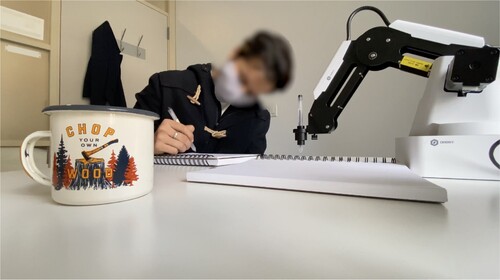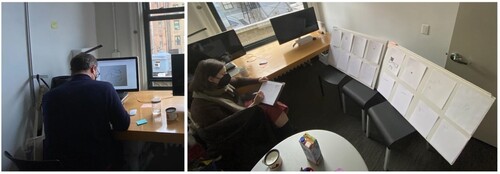ABSTRACT
Artificial Intelligence (AI) has significantly advanced in creating professional-level media content. In creative education, determining how students can benefit without becoming dependent on them is a challenge. In this study, researchers conducted an exploratory experiment that positioned AI as a relational artifact to students in a series of drawing activities and examined the potential impact of affective relations with machines in socio-cultural creative learning. The resulting artifacts, observations, and interview transcripts were analyzed using the Consensual Assessment Technique and a grounded theory approach. The study's results indicate that the design professors reliably evaluated the student drawings as more creative than the AI drawings, but neither demonstrated a consistent increase in creativity. However, the presence of AI engaged the students to explore different approaches to artistic prompts. We theorize that AI can be mediated as a learning artifact for transformative creativity if the students perceive their relationship with AI as empathetic and collaborative.
Introduction
The advent of creative AI
Generative computational models like ChatGPT and Dall-E have captured public attention for their text and image generation capabilities. These applications’ impact on education has also been broadly discussed, from limiting cognitive questioning to automation of the knowledge economy jobs (Baidoo-Anu and Owusu Ansah Citation2023; Kissinger, Schmidt, and Huttenlocher Citation2023). The advancements of these technologies are part of an effort to develop a general artificial intelligence system (Altman Citation2023; Goertzel Citation2014) where creativity is considered an essential component of human intelligence. In computational creativity research, a multidisciplinary group of researchers examines computers as autonomous creators and co-creators in their own right instead of mere tools used by humans (Veale and Amílcar Cardoso Citation2019). Some scholars consider these AI applications “creative” as they have passed a major benchmark where the artifacts from the systems, like images and text, are indistinguishable from that of humans (Guo et al. Citation2023). These technologies, for their ease of use and demonstrative value, have led to the launch of numerous commercial AI applications, from a professional-grade graphic generator to a virtual avatar speaker to copy editing, and are expected to enter the education industry (“Midjourney” Citation2023; “Copy.Ai” Citation2023; “D-ID Studio” Citation2023).
Examining how AI technologies are integrated into the educational environment is critical. In creative learning, there is a need to foster models that encourage humans and AI to enhance each other instead of automated models that create human reliance on machines for a creative generation. There are many existing frameworks on AI in education. However, according to our knowledge, none are designed primarily for learning with a focus on developing the long-term creative capabilities of the students (See, e.g. Chiu et al. Citation2023). There is a need to explore the roles of AI in creativity development that aligns with the theories on sociocultural perspectives on creativity, where creativity is viewed as an emergent phenomenon from a complex learning system (Sawyer Citation2015). Integrating AI in a learning system to develop human creativity is a wicked problem, a complex, multifaceted issue with diverse stakeholders with often conflicting interests (Rittel and Webber Citation1973). The benefits can be significant, as the combination of pedagogy and AI may provide opportunities to expand creative learning beyond subjects traditionally associated with creativity, such as art, design, or business.
Purpose of the study
In this research, we aim to explore the potential of leveraging relational dynamics between students and AI for creativity development. We have designed and developed an experiment where AI draws with the students in a position like a peer. We examined the emergent intra-psychological and inter-psychological learning dynamics with a focus on the following two main research questions:
Did AI, as a relational artifact, consistently enhance the creativity of the students or the quality of their work?
What are the causes and unexpected insights behind the outcome?
In the process of addressing the main questions, we also examined the following questions:
How reliable were design professors in evaluating the creativity of students and AI using Consensual Assessment Technique?
How did students experience creating alongside AI as a peer?
The findings from this research can yield insights into a new dimension of human-computer interaction for creativity development and contribute to developing a new pedagogy and computational system that utilizes AI for creative learning.
Artificial intelligence in context
In designing and implementing our study, we examine the following research precedents, approaches to using AI in education, research related to computational creativity and the perspective of creativity in general, and existing models of teaching and learning creativity. All these are discussed, considering their relevance to being integrated into the use of AI in creative learning.
AI in education
While the popularity of text generation models like ChatGPT are opening new debates on the roles of technology in learning, AI has been increasingly adopted in curriculum and classroom operations. A predominant model of these works is an intelligent tutoring system that enhances and increases access to personalized tutoring (Anderson, Franklin Boyle, and Reiser Citation1985; Anderson et al. Citation1995; Corbett and Anderson Citation1995). Text generative models are now considered for integration with writing seminars, craft education, test preparation, and other classroom administrative works (Bishop Citation2023; Vartiainen and Tedre Citation2023; Khan Citation2023). AI tools are adopted in assessment practices for detecting plagiarism by students who might have used a generative text model (Cotton, Cotton, and Reuben Shipway Citation2023). A growing number of researchers are examining human and machine collaborative dynamics (Ouyang and Jiao Citation2021). We incorporated these practices into designing a new AI system that seeks to result in long-term creative capacity development among students.
Computational creativity
Computational Creativity is a research domain at the intersection between creativity studies and computer science. The researchers use frameworks from psychological theories on creativity to develop an autonomous system that can produce creative solutions and artistic outputs (Colton and Wiggins Citation2012; Reddy Citation2022). These actions by computers can be categorized as combinatory, exploratory, and transformative creativity (Boden Citation1991). The first two actions operate within and at the edge of the domain knowledge space, while the last develops a new knowledge paradigm. How these systems can foster human creativity has been explored in the concept called computational co-creativity (Lubart Citation2005). For instance, in a mixed-initiative model, the computer and human user take turns in a collaborative effort that can result in increased divergent thinking (Liapis et al. Citation2016). This model provides useful insights into developing interaction design. However, it lacks the educational consideration for a transformative learning outcome where students develop creative capacities independent of the computer system. We are incorporating these theories and concepts from computational creativity practices into evaluating the student actions and the developmental impact of the system.
Multidisciplinary perspectives on creativity
Creativity is a popular research subject across disciplines (Kaufman and Sternberg Citation2019). Many definitions of creativity share two common characteristics: novelty (new) and value (usefulness) (Sternberg and Lubart Citation1999). One of the most common ways that the researchers have organized and directed their studies is a 4Ps model where the following four elements are focused on understanding creative phenomenon: the person (personality, intellect, temperament, behaviour), process (motivation, perception, and communicating), product (idea embodied into a tangible form), and press (the relationship between the human beings and environment) (Rhodes Citation1961). As the field of sociocultural psychology emerged, creativity researchers began to develop a systematic approach that incorporates cultural aspects. These approaches examined the creative phenomenon beyond the specific elements themselves (Glăveanu Citation2015). They focused on the interaction among the ecological elements that are named as actors, actions, audiences, artefacts, and affordances. (Glăveanu Citation2013). From the socio-cultural perspective, the ability to make something creative is not an inherent trait that exclusively belongs to a ‘genius.’ Everyone can exercise creativity on their personal level (little-c). If society and field experts recognize their novelty and value, they are considered eminently creative (big-C) by society (Kozbelt, Beghetto, and Runco Citation2010). Creativity is not a static entity bound only in the individual mind but is continuously formed and reformed in the flux of interaction and activities. The person is embedded in a social and cultural historical system (Glăveanu et al. Citation2019). Creativity is considered dynamic, materialized in cultural practices, and subject to transformations (Sawyer Citation2021). It is mediated through historically developing cultural symbol systems and the artifacts we use. Our understanding of creativity is changing historically, shaped, and transformed over long periods of time. We incorporated these perspectives of creativity in designing the experiments, especially how the students and professors interact with generative AI.
Teaching creativity
Creative capacity, which encompasses meta-cognitive and emotional skills such as critical thinking, reflection, synthesis, divergent thinking, empathy, and collaboration, is considered an essential learning outcome for the twenty-first-century knowledge economy (Howells Citation2018). There are two main perspectives on teaching students to be more creative (Sawyer Citation2015). One school of thought observes creativity as a general skill where being creative in one domain can translate into being creative in another domain. The research in this approach has contributed to the conceptualization of psychological skills like lateral thinking and the development of its training regiment and personality testing (Torrance Citation1972). However, no conclusive evidence exists that creativity is a domain-transferable skill (Baer Citation1998). This finding aligns with the sociocultural perspective of creativity, a concept that deems creativity as a trait determined by the experts and peers in the subject domain (Amabile Citation1982). Other researchers look at creativity as domain-specific skills where a level of domain knowledge and experience is a prerequisite for producing novel and useful works (Ericsson Citation2002). In our studies, we designed the experiment on developing creative capacity where one can expand one’s knowledge in drawing activities through iterations.
Creative learning
The relationship between creativity and learning has been explored in various contexts, from education policies to creative problem-solving. (Sefton-Green et al. Citation2011; Truman Citation2011) While creativity and learning had been understood as separate and individual-driven processes, new approach from sociocultural perspectives examined them as co-occurring processes (e.g. Eteläpelto & Lahti, Citation2008; Glăveanu Citation2015; Gajda, Beghetto, and Karwowski Citation2017). Learning and creativity do not take place out of nowhere, but as whole processes, they arise from the interactions among the individual, the community and the broader cultural environment (Lemmetty et al. Citation2021). The researchers argue the processes of creative activity are to be studied as learning (Lemmetty and Collin Citation2021). One of the approaches looks at creative learning as a concept that combines intra-psychological and inter-psychological processes and results in new and personally meaningful understanding for oneself and others (Beghetto Citation2016). In the intra-psychological sphere, the focus is on the role of creativity in changing personal understanding (creativity in learning). In the inter-psychological domain, the emphasis is on the role of sharing personal learning in making creative contributions to others (learning in creativity). For instance, a student can develop a way to solve a problem on their own by combining different methods from their past experience. This combination can lead to a useful solution that is new to the student. The student then shares the new ideas with the peers in class. In discussion, the class shares their perspectives and develops a new understanding. The class’ ideas are shared online and the online community of wider learners and teachers adopt the new method. We utilized this model in this study to design and assess creative development environments with AI at intra- and inter-psychological levels, affecting personal and social creative capacity, respectively.
Relational artifacts
Relational artifact is a concept that describes the phenomenon of people not only anthropomorphizing but entering an affective state with computers (Turkle et al. Citation2006). The roles of computers in human relations have been shifting from objective to subjective relations, where instead of humans directing the machine, the characteristic of the machine is affecting humans’ understanding and behaviour (Turkle Citation1982). A famous analogy is a computer as a Rorschach test, where people project their emotions and ideas onto the computers. The relational artifacts take a step further when people try to satisfy their emotional needs in their interaction with the computer. Their emotional well-being is affected by their perception of computers. The advancements in generative capacities of computational systems and common anthropomorphic attitudes toward AI allow us to design a learning system where AI acts as a relational object in the context of creative learning. The different role that artifacts play in creative activities has been examined in art and design education setting (Sawyer Citation2022). In addition, the zone of proximal development theory describes that learners grow when interacting with a more knowledgeable or skillful peer (Vygotsky and Cole Citation1978). Regarding creative development, we assume that one’s creative capacity can expand in a co-creative dynamic. Here, AI does not act as a tutor with a fixed knowledge domain but grows alongside the learner as a peer. This idea aligns with the conceptual domain described in the computational creativity framework on combinatory, exploratory, and transformative creativity. We theorize that AI as a peer can support students to expand their personal knowledge space, engaging in combinatory and exploratory creative actions.
Once the domain knowledge is fully explored, the student can take a creative action where learning happens in a new knowledge domain. Based on these concepts, situating AI as a relational artifact in the classroom can result in creative learning that results in transformative creativity ().
Figure 1. A diagram that combines the concepts of the zone of proximal development, sociocultural creative learning, and three types of activities from computational creativity. The core of circle represents the student’s existing knowledge. Through combinatory and exploratory activities, the students can expand their knowledge to the limits of the existing conceptual space of domain knowledge. The transformative creativity that is paradigm shifting exists outside the known boundaries of the conceptual space of domain knowledge.
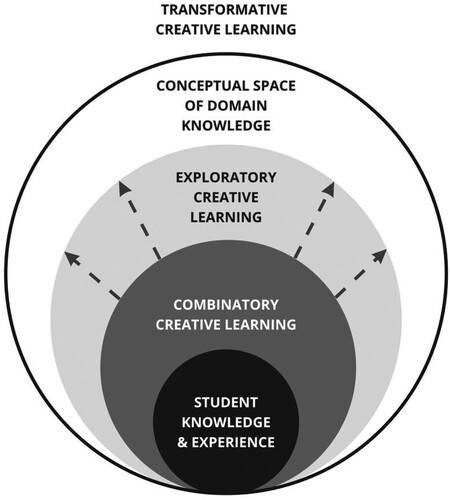
Research design
In developing a model for integrating AI in creative education, we engaged in a mixed methods research methodology and design through research processes where iterative prototyping and implementation are used to generate insights for the final design outcome (Creswell Citation2014; Stappers Citation2014; Leinonen Citation2010). Based on the conceptual theories relevant to creative learning and AI, we designed and conducted an exploratory experiment where AI acts as a relational artifact in a creative learning environment. The study consisted of two types of sessions: Artifact Creation Sessions and Artifact Evaluation Sessions.
Artifact Creation Sessions: In these sessions, design students created a series of hand-drawn illustrations alongside the AI physically present in the room as a robotic arm. A drawing activity was selected because it is one of the foundational learnings in traditional creative industries and co-creative drawing systems are an active area of research in the computational creativity community (Davis et al. Citation2019). Students and AI were prompted to draw four iterations of two different creative illustration prompts.
Artifact Evaluation Sessions: In these sessions, design professors evaluated the artifacts made by students and AI from both creative illustration prompts. Professors evaluated the artifacts using the Consensual Assessment Technique, a highly regarded method in social creativity research (Hennessey, Amabile, and Mueller Citation2011). By relying on social dynamics and collective domain experts’ opinions, the technique is adaptable for assessing creativity in various domains (Baer and McKool Citation2009). A panel of domain experts rates the creativity of artifacts in a randomized order independently from one another. The artifacts were evaluated based on the eight criteria on the researchers selected to convey different aspects of creative works. While the same evaluation criteria are given, they were to use their own subjective interpretation of the categories. If there is consistency among the evaluators of the domain experts, it indicates the existence of the knowledge domain and criteria for judging something creative within the domain (Baer and Kaufman Citation2019). Professors also evaluated the artifacts in the form of design critique, a common practice in design pedagogy. All iterations of artifacts are observed to assess if the creativity level has changed over time as a proxy of seeing if the students’ creativity level has increased during the session.
A total of 10 participants were engaged in the study. Six design students engaged in a series of Artifact Creation Sessions with AI, and four design professors engaged in Artifact Evaluation Sessions. The age of students ranged from 23 to 26 years old (Mean = 24.5, Standard Deviation = 1.26, female = 4). All the students were enrolled in the graduate-level interdisciplinary design programme at the time of the study. Four of the students had undergraduate training in drawing and prior work experiences in the creative industry, such as UX design, industrial design, graphic design, and branding. Four design professors engaged in the Artifact Evaluation Sessions, aged between 40 and 62. All were full-time faculty members at the same design school as the students, but they taught in programmes other than the ones where the students were enrolled. Their experience as design educators ranged from 13 to 20 years.
Artifact creation sessions
Environment
Artifact Creation Sessions were performed in a non-descriptive multi-functional room. At each session, a design student sat beside a robotic arm at a round table. The robotic arm was connected to a laptop sitting on the table. The research team managed the laptop, and the laptop screen was not visible to the participant, only to the research team. The student and AI (here, we recognize the AI as a combination of the robotic arm, the laptop, and the machine learning algorithm) were given the same drawing illustration materials (a fine-tipped illustration pen and a blank notepad). For the first four drawing rounds of each session, a mug was placed on the table to serve as a drawing object. After each round, a researcher processed photos of the artifacts drawn by AI and students on the laptop and generated images using machine learning techniques, which in turn affected the stylistic characteristics and images that the AI would draw with a robotic arm in the preceding round. For transferring stylistic characteristics like sketching between the artifacts, we used a fast artistic style transfer module for its speed and capability to accommodate multiple styles (Ghiasi et al. Citation2017). For generating images from a text prompt (Text-to-Image), we used the VQGAN-CLIP method, which combines the generative and discriminative capabilities of VQGAN and CLIP, respectively (Esser, Rombach, and Ommer Citation2021; Radford et al. Citation2021).
Data
In Artifact Creation Sessions, three types of data were captured: (1) human and AI-drawn artifacts, (2) video footage of human-AI interaction during the creative session, and (3) semi-structured interviews with design students at the end of each drawing session. The interview was transcribed for AI and human content analysis.
Activities
In the study, we conducted six Artifact Creation Sessions, one for each of the six design students. At each session, we used two creative illustration prompts. Students and AI drew both prompts four times, resulting in eight artifacts (drawings) from the student and eight artifacts from the AI. After each round of drawing, students engaged in a semi-structured interview led by the research team. These interviews prompted students to reflect upon and describe their experience during each session and focused explicitly on notions of creativity, learning, and sensing the presence of AI. Overall, each Artifact Creation Session lasted approximately three hours.
We designed the sessions to be iterative as we perceived time as a critical component in creative learning. Time is a critical design element in reflecting intra-psychologically and discussing it on an inter-psychological level. From our pedagogical experience in design education, the peer settings can accelerate the speed of improving their creative works via copying, ideating, and incorporating feedback. At least, educators can observe the influence of their peers in their work. In addition, the students were aware the focus of the research is on creativity. They are not asked to be more creative in subsequent sessions. They are given the same prompt just as the AI. The students determined themselves how they approached the prompt each time. The students were informed that the AI was learning from them but weren’t told exactly how. These purposeful ambiguities and openness are meant to create an environment the students construct their own understanding of the situation and approach the assignments over time ().
Creative Illustration Prompt 1: For the first creative illustration prompt, a mug was visibly presented to the student at the table. A picture of the same mug was processed for the initial AI drawing. Students were instructed with the illustration prompt: “Draw this cup.” After each drawing round, researchers took pictures of the student and AI artifacts and processed them using the Style-Transfer technique, which generated a new image that, in turn, was used to instruct the AI to draw for the subsequent round. This research design was to mimic how both the students and AI engage in intra-psychological creative learning. The students verbalized their process with semi-structured interviews at the end of the round. Concurrently, the AI was reflecting on the students’ work through the Style-Transfer technique, where the visual outputs from the process were like the mental images in the human creative learning process. In this technical execution, the AI does not have a conceptual representation as the students do. However, by using the picture of the cup that the students were asked to look at and draw and copyng the styles or forms of the students’ drawings in the subsequent iterations, AI was going through a form of the reflective process, just like a human peer would see the cup, see the peer's drawing and executing it.
Creative Illustration Prompt 2: For the second creative illustration prompt, students were instructed to: “Draw a basket full of fruits on a wooden table.” The AI created its first drawing using the Text-to-Image technique with the same prompt. While the input image to the AI was the same, the execution varied depending on the drawing condition. Hence, the image was different for each participant. There were four drawing rounds. After the initial drawing session, the student and AI underwent the same process as the first creative illustration prompt but with one change in the Style-Transfer process. To elicit two different types of learning behaviour by the AI, researchers switched the sources of the base image and style image between the two creative illustration prompts. For instance, if the first creative illustration prompt used the AI’s image from the previous round as a base image and the human’s image from the previous as a style image, and the second creative illustration prompt used the human’s image from the previous round as the base image and the AI’s image from the previous round as a style image.
These Artifact Creation Sessions resulted in a total of 96 artifacts: 48 were generated by humans and 48 by AIs.
Artifact evaluation sessions
Environment
The Artifact Evaluation Sessions were held in a single-room office. At the beginning of the session, a design professor sat in front of a computer monitor. The pictures of the artifacts from all Artifact Creation Sessions were presented in a randomized order so that the professor cannot identify the works of the specific student or AI by the order of presentation. The order was also different for each professor. This is an important research design feature for assessing the reliability of the evaluation process. Afterward, the artifacts were grouped into their respective Artifact Creation Session and pinned on foam boards, a common practice in design pedagogy. The professor conducted a design critique review focusing on any change or peer-to-peer influence between iterations.
Data
During Artifact Evaluation Sessions, two types of data were captured: (1) CAT scores for each artifact by each design professor and (2) semi-structured interviews with design professors at the end of the evaluation session. The semi-structured interviews were transcribed for AI and human content analysis.
Activities
Using these artifacts, we conducted a total of four Artifact Evaluation Sessions. A design professor was instructed to evaluate the artifacts at each session using two different methods in an individual setting ().
Consensual Assessment Technique: The professors were instructed to evaluate 48 artifacts from the first creative illustration prompt, “Draw This Cup.” Following the technique standards, each professor reviewed the artifacts in a randomized order. Professors were instructed to use the Likert Scale and rate from 1 to 7 (1 = low; 7 = high) using their subjective judgment of the following eight categories: creative, novel, surprising, artistic value, technical ability, expressive, interesting, and moving. Afterward, the professors evaluated 48 artifacts from the second prompt, “Draw a basket full of fruits on a wooden table,” following the same instruction.
Design Critique: The professors engaged in a design critique where the artifacts from the eight rounds of all Artifact Creation Sessions were pinned up next to one another on foam boards. Professors were instructed to evaluate their overall assessment of the participant using the same Likert scale for the following six categories: creative, collaborative capacity, critical thinking, technical capacity, artistic capacity, and do I want this participant in my class?.
Lastly, a semi-structured interview was conducted, assessing each professor's overall experience and insights. Each session lasted approximately two hours.
Findings
We conducted two types of analysis of the data from the experiment. The first is quantitative data analysis from Consensual Assessment Technique. We looked at the validity of the research by looking at the inter-rater reliability of the evaluation data and the evidence of if the system has resulted in human participants increasing their capacity. In order to gain insights into the reasons for the action of the research participants, we used a grounded theory approach to analyze the interview transcript and observation data in order to understand the causes and create a “theory” from the insights (Glaser, Strauss, and Strutzel Citation1968; Charmaz Citation2014). The researchers engaged in open coding to find emerging themes from the data. Both the observation notes and the interview transcript were coded. The concepts of combinatory, exploratory, and transformative creative action from computational creativity were used to categorize the type of learning activities by AI and students. The types of activities and roles are translated into the creative learning process to delineate learning between intra-psychological and inter-psychological learning.
Consistency of CAT between AI and humans
First, we examined the inter-judge reliability of the rating for each evaluation question. The inter-judge reliability is defined as the consistency of measurement obtained when different judges independently administer the same test to the subjects. Cronbach’s coefficient alpha showed a high degree of agreement between the professors, alpha = 0.91, alpha = 0.97, and alpha = 0.88 for the category ‘creative’ for the artifacts from the first prompt, second prompt, and last design critique session, respectively (McHugh Citation2012). This established consistency among the professors in evaluating the creativity level of the works, and we moved on to address the first research question on whether AI as a relational artifact enhanced creativity.
No evidence of enhancement, but more dynamic
We found that AI as a relational artifact did not enhance the creativity of the students but made the creativity levels of students more dynamic, as in fluctuating between iterations. Analyzing the CAT scores, we found that the professors consistently evaluated the student artifacts as more creative than AI ones. However, in comparing the student artifacts of the earlier rounds to those of the later rounds, the artifacts were not considered more creative in the later rounds. We interpret these results as the students’ creativity was not enhanced during the experiment. We noted that the four iterative sessions might be too short to register a significant developmental change in students’ creative capacity. However, we anticipate at least a consistent or incremental tendency in creativity levels in an iterative peer learning environment ().
Figure 4. Charts that compare the average evaluation scores of students and AI during Artifact Creation Sessions Each line indicates the average score of the evaluation category over the iterative session. The blue line represents AI, and the other colour lines represent student participants. The X-axis represents the four iterative sessions in each chart, and the Y-axis represents the scale score. The left charts are the scores from the first prompt, “Draw this cup,” and the right charts are those from the second prompt, “Draw a basket full of fruits on a wooden table.”. The charts do not indicate the enhancement of students’ creativity scores over the iterative sessions but capture the dynamic tendency of the student’s creativity across the evaluation categories.
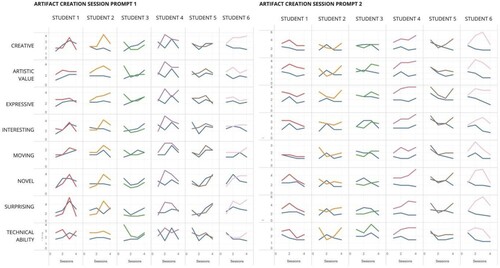
However, we noticed the variable tendencies among the creativity level of the students’ artifacts, in contrast to the AI's. A professor has described AI to be a “one-trick pony.” Another evaluator would say that the work has become stale once the initial wonder and interest have passed. AI artifacts are not interesting as they draw based on the same interpretation of the prompt repeatedly. One of the professors described AI as a student who is not collaborative without the capacity for change. On the other hand, students’ creativity levels are not necessarily growing over time, but AI, as a relational artifact, brought out the dynamic nature of their creative capacity. To understand its causes, we examined the data from the interview and observation.
AI presence to increased affordance
We believe the dynamic aspects of the creativity score of the students are the result of increased affordance of the environment due to the presence of AI. In the first drawing session, when the students were asked to draw the cup, the interpretation of the instruction was often literal. The students attempt to draw the cup as realistically as possible. In the end, however, they saw how the AI drew almost in an abstract style based on the same instruction. They realized the possibility of interpreting the instruction loosely. The reason the AI’s work looks abstract is not necessarily intended. However, in the technical execution, from computer graphic images to physical drawing, the execution can be flexible as an artist would extemporaneously make decisions while making art. Seeing AI breaking the initial expectation of the learning environment gave the students the possibility to combine and explore different styles and interpretations of the instruction. One of the student participants explains:
Okay. I don't really just want to draw another cup again. So, what else can I do? [T]he AI drawing, the absence of lines, just kind of like what spurred some ideas […]. Initially, I was like, what if I drew everything but the cup, and I don't know, just drew the whole table with the cups?
— Student Participant 6 Session 3
Figure 5. Artifacts from the Artifact Creation Session Participant 4 Prompt 1 “Draw this cup.” The top images are drawn by the student participant, and the bottom images are by the AI over the iterative sessions. The students’ images from the first to last session show their interpretation of the prompt moving from literal to experimental, instigated by the first image by the AI.
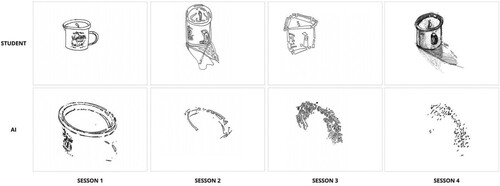
Combinatory and explorative, but not transformative creativity
Even though the increased affordance of the space resulted in combinatory and exploratory creative actions, the professors did not consider the produced works are transformative creative. We believe this is due to the breakdown of the learning relationship between the students and AI. The initial presence often translated into a sense of “a weird kinship” as they were doing the same activity together in the room. Knowing from the instruction that the AI is learning from them, the students paid extra attention to the details of their works and those of the AI, trying to interpret not only the execution of their works but also how much of their work was influencing the AI. However, with limited means of communicating with AI about what it was learning and drawing, their perception of the relationship often devolves into a sense of abandonment. They perceived that AI was acting independently without regard to their efforts to collaborate. This is notable as they expected creative collaboration as a norm in their design education environment despite the researchers giving no explicit instruction. Feeling spurn by their perceived slight, they focused on their works. There are multiple incidences of their expressed frustration:
Yeah, so I would assume that maybe [AI] is not interested in collaboration, or maybe they just want to mind their own business, to let them be.
— Student Participant 1 Session 3
I also think, for this AI, it's not taking into account there's three other people in the room, and it's midday, and ran out from one class, have another three-hour class after this. The AI is just kind of like doing its AI thing.
— Student Participant 5 Session 1
I would be affected if I resonated with [the AI as I did in the earlier session], but for this context, I haven't been resonated with the AI. So, we are like doing our separate stuff.
— Student Participant 2 Session 2
Figure 6. The top image from the session where the student used the cup to complete the drawing prompt differently. The images over the iterative sessions show the drastic change in interpretation and creative exploration.
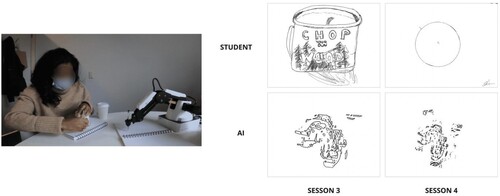
Yeah, well, previously, when I was flipping the cup around, I just was looking at the different sides to it, and I noticed the like bird's eye view, and that's all I wanted to do. I felt like if this drawing was on the table, and this was on the table that I totally am going to stand up and look down what, what was it? They would figure it out. So that like was enough of a depiction. And then I got a little cocky because this thing was taking forever. So I signed it. I was like, “Look at how fast I did that.”
— Student Participant 5 Session 4
Figure 7. The visual artifacts and interview from the iteration sessions show the students’ exploration that are influenced by the AI’s drawing. The student refers to incorporating dots in their drawing similar to the AI’s drawings from the previous session. However, the interview revealed the student’s uncertainty toward the AI’s drawing. The student was influenced by AI and the concepts, but they weren’t actively building on the concepts as it would have happened in person-to-person collaboration.
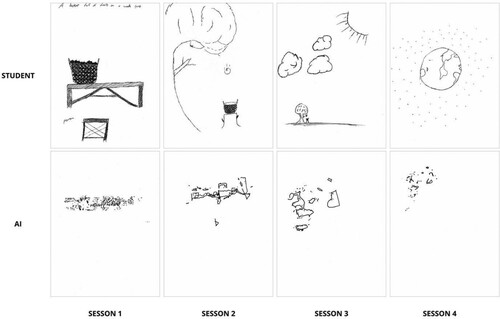
I wouldn't know how else to draw them, but in my head, it was kind of this poetic justice of zooming out one level by one level, and then ultimately, at the most zoomed-out level where everything's just dots. All the AI is doing is drawing dots, not all that it's doing, but a lot of what it's doing. […] I don't think I could say for sure that all the dots the AI has been drawing are stars, but also couldn't definitively say that none of the dots the AI has been drawing are stars.
— Student Participant 6 Session 8
Figure 8. An incident where the student is trying to empathize with AI and reflect upon their creative practice.
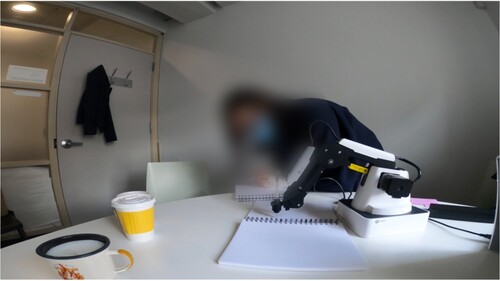
[B]efore this experiment, I was thinking, “Okay, AI is just trying to mimic what human does. And AI is there to help humans to be more creative.” But, I feel like in that kind of relationship, I'm not really cooperating with the AI. I'm just letting it be a tool. And that doesn't really help my creativity because I'm still going to do my stuff and stick to my style without learning anything from it. So, I feel like putting myself in a collaborating position really changed the way I draw, and changed the way I think about the relationship between humans and AI. And I think that is where the creativity is sparked, because only when the mindset changes, I can do something totally different.
— Student Participant 2 Session 8
By looking at the task from the AI’s perspective, one’s explorative learning area can expand more quickly in the conceptual domain than doing the task alone. This opens the possibility where AI as a relational artifact can create combinatory, exploratory, and transformative creativity in the inter-psychological space of creative learning. Communicating with an AI peer and understanding its knowledge and experience can lead to a fast coverage of the conceptual knowledge domain. This expansion of one’s exploratory creative domain may be the type of learning that can develop capacity for a transformative breakthrough ().
Figure 9. Diagrams that compare the difference of conceptual space coverage between independent and relational creative learning. The darkest coloured circle represents the existing knowledge of a learner. The expanding circles represent learning. The most outer ring circle represents the limits of the existing knowledge domain. The left diagram depicts two learners without a relationship where they cover less of the conceptual domain by working independently. The affordance increases for each learner as they can see the other’s work. However, they cannot cover the existing domain as quickly and widely as they would have if there were in a collaborative relationship (right). The rapid coverage of the existing knowledge domain (exploratory creativity) can increase the likelihood of creating new knowledge outside of the domain (transformative creativity).
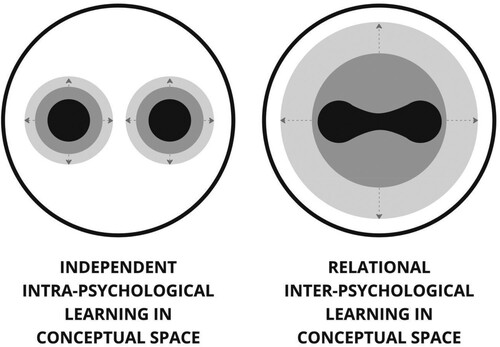
To expand their conceptual domain by combining with others, the students need a better method of communication, self-reflection, and empathy for a sustainable collaborative relationship with AI. The inter-psychological creative learning with AI can result in personal transformative learning and a higher likelihood of producing novel works outside the existing conceptual space.
Conclusion
In this study, we examined the emergent intra-psychological and inter-psychological creative learning when AI is situated as a relational artifact in a series of creative drawing sessions. While we found that relational dynamics did not enhance the students’ creativity but increased awareness of what is possible in the situation and inspired the students to explore different types of drawing styles and interpretations of the prompt. AI as a relational artifact can be an effective learning tool for encouraging exploratory and combinatory creativity activities. The results gave insights into future research design where enhanced communication and empathetic dynamics between students and AI may result in students rapidly exploring the conceptual knowledge space and transforming themselves with an enhanced creative capacity. The technical aspect of the study can be improved to make the communication between the student and the AI more constructive toward a sustainable peer relationship. We can explore the different configurations of the research design for AI to make it more effective as an environmental affordance for enhancing the creativity of human artwork in a short time. AI and humans may receive more detailed and specific prompts through iterative aspects that encourage more exploratory activities within the conceptual space. AI and student communication can improve where the AI explains their artwork through text or speech and comments on the student’s works, and the student can talk to the AI. AI can include a face or emotional cues besides an arm to foster non-verbal communication. Varied group dynamics can be explored as well. The physical positioning of the human and AI robotic arms can be different, like situated side-by-side instead of across the table, to encourage more collaborative than adversarial dynamics. The settings with or without AI in a group with other human students can result in a compelling comparative study. Lastly, considering the impact of these types of technology and their limitations on learning capacity, along with creativity being the central focus in early childhood education, the study with the younger demography can result in additional insights into building a more comprehensive system for artificial creative learning. These different explorations of the roles of AI in creative learning can ultimately result in creating a new pedagogy and systematic model of integrating AI in creative education.
Research ethics
The research followed the research ethics review process of the Aalto University Research Ethics Committee and the Finnish national guidelines. All the subjects have provided appropriate informed consent during the research.
Declaration of interest statement
The authors report that there are no competing interests to declare.
Acknowledgments
These studies would not have been possible without our participants, to whom we offer thanks for their cooperation and insights.
Disclosure statement
No potential conflict of interest was reported by the author(s).
Additional information
Funding
Notes on contributors
Jeongki Lim
Jeongki Lim is an Assistant Professor of Strategic Design and Management at Parsons School of Design at The New School and a doctoral researcher at the Learning Environments Group at Aalto University.
Teemu Leinonen
Teemu Leinonen is an Associate Professor of New Media Design and Learning at the Aalto University School of Arts, Design and Architecture.
Lasse Lipponen
Lasse Lipponen is a Professor of Education at the Faculty of Educational Sciences, University of Helsinki.
Henry Lee
Henry Lee is a Design Research and Strategy Practitioner and a Faculty at the Parsons School of Design at The New School.
Julienne DeVita
Julienne DeVita is a Strategic Foresight Practitioner and a Faculty of Futures Studies and Speculative Design at Parsons School of Design at The New School.
Dakota Murray
Dakota Murray is a Data Scientist at Digital Science and holds an affiliation with the Center for Complex Network Research at Northeastern University.
References
- Altman, Sam. 2023. “Planning for AGI and Beyond.” Accessed March 20. https://openai.com/blog/planning-for-agi-and-beyond.
- Amabile, Teresa M. 1982. “Social Psychology of Creativity: A Consensual Assessment Technique.” Journal of Personality and Social Psychology 43 (5): 997–1013. https://doi.org/10.1037/0022-3514.43.5.997.
- Anderson, John R., Albert T. Corbett, Kenneth R. Koedinger, and Pelletier Ray. 1995. “Cognitive Tutors: Lessons Learned.” Journal of the Learning Sciences 4 (2): 167–207. https://doi.org/10.1207/s15327809jls0402_2.
- Anderson, John R., C. Franklin Boyle, and Brian J. Reiser. 1985. “Intelligent Tutoring Systems.” Science 228 (April): 456–62. https://doi.org/10.1126/science.228.4698.456.
- Baer, John. 1998. “The Case for Domain Specificity of Creativity.” Creativity Research Journal 11 (2): 173–77. https://doi.org/10.1207/s15326934crj1102_7.
- Baer, John, and James C. Kaufman. 2019. “Assessing Creativity with the Consensual Assessment Technique.” In The Palgrave Handbook of Social Creativity Research, edited by Izabela Lebuda and Vlad Petre Glăveanu, 27–37. Palgrave Studies in Creativity and Culture. Cham: Springer International Publishing. https://doi.org/10.1007/978-3-319-95498-1_3.
- Baer, John, and Sharon McKool. 2009. “Assessing Creativity Using the Consensual Assessment Technique.” Handbook of Research on Assessment Technologies, Methods, and Applications in Higher Education, 65–77. https://doi.org/10.4018/978-1-60566-667-9.ch004.
- Baidoo-Anu, David, and Leticia Owusu Ansah. 2023. “Education in the Era of Generative Artificial Intelligence (AI): Understanding the Potential Benefits of ChatGPT in Promoting Teaching and Learning.” SSRN Scholarly Paper. Rochester, NY. doi:10.2139/ssrn.4337484.
- Beghetto, Ronald A. 2016. “Creative Learning: A Fresh Look.” Journal of Cognitive Education and Psychology 15 (1): 6–23. https://doi.org/10.1891/1945-8959.15.1.6.
- Bishop, Lea. 2023. “A Computer Wrote This Paper: What ChatGPT Means for Education, Research, and Writing.” SSRN Scholarly Paper. Rochester, NY. doi:10.2139/ssrn.4338981.
- Boden, Margaret A. 1991. The Creative Mind: Myths & Mechanisms. The Creative Mind: Myths & Mechanisms. New York, NY, US: Basic Books.
- Charmaz, Kathy. 2014. Constructing Grounded Theory. 2nd ed. London ; Thousand Oaks, Calif: SAGE Publications Ltd.
- Chiu, Thomas K. F., Qi Xia, Xinyan Zhou, Ching Sing Chai, and Miaoting Cheng. 2023. “Systematic Literature Review on Opportunities, Challenges, and Future Research Recommendations of Artificial Intelligence in Education.” Computers and Education: Artificial Intelligence 4 (January): 100118. https://doi.org/10.1016/j.caeai.2022.100118.
- Colton, Simon, and Geraint A. Wiggins. 2012. “Computational Creativity: The Final Frontier?” In ECAI 2012—20th European Conference on Artificial Intelligence, 27-31 August 2012, Montpellier, France - Including Prestigious Applications of Artificial Intelligence (PAIS-2012) System Demonstration, 21–26. IOS Press. https://doi.org/10.3233/978-1-61499-098-7-21.
- “Copy.Ai.” 2023. CopyAI, Inc. Accessed March 20. https://www.copy.ai/.
- Corbett, Albert T., and John R. Anderson. 1995. “Knowledge Tracing: Modeling the Acquisition of Procedural Knowledge.” User Modelling and User-Adapted Interaction 4 (4): 253–78. https://doi.org/10.1007/BF01099821.
- Cotton, Debby R. E., Peter A. Cotton, and J. Reuben Shipway. 2023. “Chatting and Cheating: Ensuring Academic Integrity in the Era of ChatGPT.” Innovations in Education and Teaching International, 1–12. https://doi.org/10.1080/14703297.2023.2190148.
- Creswell, John W. 2014. Research Design: Qualitative, Quantitative and Mixed Methods Approaches. 4th edition. Thousand Oaks: SAGE Publications, Inc.
- Davis, N., Safat Siddiqui, Pegah Karimi, M. Maher, and Kazjon Grace. 2019. “Creative Sketching Partner: A Co-Creative Sketching Tool to Inspire Design Creativity.” In Tenth International Conference on Computational Creativity. https://www.semanticscholar.org/paper/Creative-Sketching-Partner%3A-A-Co-Creative-Sketching-Davis-Siddiqui/5120afadd8d12d83e3d200014d255c1c989a5d9d.
- “D-ID Studio.” 2023. De-Identification Ltd. Accessed March 20. https://studio.d-id.com/.
- Ericsson, K. Anders. 2002. “Attaining Excellence Through Deliberate Practice: Insights from the Study of Expert Performance.” In Teaching and Learning, 4–37. John Wiley & Sons, Ltd. https://doi.org/10.1002/9780470690048.ch1.
- Esser, Patrick, Robin Rombach, and Bjorn Ommer. 2021. “Taming Transformers for High-Resolution Image Synthesis.” In Proceedings of the IEEE/CVF Conference on Computer Vision and Pattern Recognition, 12873–83. https://openaccess.thecvf.com/content/CVPR2021/html/Esser_Taming_Transformers_for_High-Resolution_Image_Synthesis_CVPR_2021_paper.html.
- Eteläpelto, A., and J. Lahti. 2008. “The Resources and Obstacles of Creative Collaboration in a Long-Term Learning Community.” Thinking Skills and Creativity 3 (3): 226–240. http://doi.org/10.1016/j.tsc.2008.09.003.
- Gajda, Aleksandra, Ronald A. Beghetto, and Maciej Karwowski. 2017. “Exploring Creative Learning in the Classroom: A Multi-Method Approach.” Thinking Skills and Creativity 24 (June): 250–67. https://doi.org/10.1016/j.tsc.2017.04.002.
- Ghiasi, Golnaz, Honglak Lee, Manjunath Kudlur, Vincent Dumoulin, and Jonathon Shlens. 2017. “Exploring the Structure of a Real-Time, Arbitrary Neural Artistic Stylization Network.” In Procedings of the British Machine Vision Conference 2017, 114. London, UK: British Machine Vision Association. https://doi.org/10.5244/C.31.114.
- Glaser, B. G., A. L. Strauss, and E. Strutzel. 1968. “The Discovery of Grounded Theory; Strategies for Qualitative Research.” Nursing Research 17 (4): 364.
- Glăveanu, Vlad Petre. 2013. “Rewriting the Language of Creativity: The Five A’s Framework.” Review of General Psychology 17 (1): 69–81. https://doi.org/10.1037/a0029528.
- Glăveanu, Vlad Petre. 2015. “Creativity as a Sociocultural Act.” The Journal of Creative Behavior 49 (3): 165–80. https://doi.org/10.1002/jocb.94.
- Glăveanu, Vlad Petre, Ingunn Johanne Ness, Barbara Wasson, and Todd Lubart. 2019. “Sociocultural Perspectives on Creativity, Learning, and Technology.” In Creativity Under Duress in Education?, edited by Carol A. Mullen, 3:63–82. Cham: Springer International Publishing. https://doi.org/10.1007/978-3-319-90272-2_4.
- Goertzel, Ben. 2014. “Artificial General Intelligence: Concept, State of the Art, and Future Prospects.” Journal of Artificial General Intelligence 5 (1): 1–48. https://doi.org/10.2478/jagi-2014-0001.
- Guo, Biyang, Xin Zhang, Ziyuan Wang, Minqi Jiang, Jinran Nie, Yuxuan Ding, Jianwei Yue, and Yupeng Wu. 2023. How Close Is ChatGPT to Human Experts? Comparison Corpus, Evaluation, and Detection.” arXiv. doi:10.48550/arXiv.2301.07597.
- Hennessey, B.A., T.M. Amabile, and J.S. Mueller. 2011. “Consensual Assessment.” In Encyclopedia of Creativity, 253–60. Elsevier. https://doi.org/10.1016/B978-0-12-375038-9.00046-7.
- Howells, K. 2018. “The Future of Education and Skills: Education 2030: The Future We Want.” Working paper. Paris: OECD. http://www.oecd.org/education/2030/E2030%20Position%20Paper%20(05.04.2018).pdf.
- Kaufman, James C., and Robert J. Sternberg, eds. 2019. The Cambridge Handbook of Creativity. 2nd ed. Cambridge Handbooks in Psychology. Cambridge: Cambridge University Press. https://doi.org/10.1017/9781316979839.
- Khan, Sal. 2023. “HArnessing GPT-4 so That All Students Benefit. A Nonprofit Approach for Equal Access!” Khan Academy Blog. March 14. https://blog.khanacademy.org/harnessing-ai-so-that-all-students-benefit-a-nonprofit-approach-for-equal-access/.
- Kissinger, Henry, Eric Schmidt, and Daniel Huttenlocher. 2023. “Opinion | ChatGPT Heralds an Intellectual Revolution.” Wall Street Journal, February 24, sec. Opinion. https://www.wsj.com/articles/chatgpt-heralds-an-intellectual-revolution-enlightenment-artificial-intelligence-homo-technicus-technology-cognition-morality-philosophy-774331c6.
- Kozbelt, Aaron, Ronald A. Beghetto, and Mark A. Runco. 2010. “Theories of Creativity.” In The Cambridge Handbook of Creativity, edited by James C. Kaufman and Robert J. Sternberg, 1st ed., 20–47. Cambridge University Press. https://doi.org/10.1017/CBO9780511763205.004.
- Leinonen, Teemu. 2010. Designing Learning Tools. Methodological Insights. Aalto University. https://aaltodoc.aalto.fi:443/handle/123456789/11661.
- Lemmetty, Soila, and Kaija Collin. 2021. “Self-Directed Learning in Creative Activity: An Ethnographic Study in Technology-Based Work.” The Journal of Creative Behavior 55 (1): 105–19. https://doi.org/10.1002/jocb.438.
- Lemmetty, Soila, Kaija Collin, Vlad Petre Glăveanu, and Panu Forsman, eds. 2021. Creativity and Learning: Contexts, Processes and Support. Palgrave Macmillan.
- Liapis, Antonios, Georgios N. Yannakakis, Constantine Alexopoulos, and Phil Lopes. 2016. “Can Computers Foster Human Users’ Creativity? Theory and Praxis of Mixed-Initiative Co-Creativity.” Digital Culture & Education 8 (2). http://www.digitalcultureandeducation.com/uncategorized/liapis-html/.
- Lubart, Todd. 2005. “How Can Computers Be Partners in the Creative Process: Classification and Commentary on the Special Issue.” International Journal of Human-Computer Studies 63 (4-5): 365–69. https://doi.org/10.1016/j.ijhcs.2005.04.002.
- McHugh, Mary L. 2012. “Interrater Reliability: The Kappa Statistic.” Biochemia Medica 22 (3): 276–82. https://doi.org/10.11613/BM.2012.031
- “Midjourney.” 2023. Midjourney, Inc. Accessed March 20. https://www.midjourney.com/.
- Ouyang, Fan, and Pengcheng Jiao. 2021. “Artificial Intelligence in Education: The Three Paradigms.” Computers and Education: Artificial Intelligence 2 (January): 100020. https://doi.org/10.1016/j.caeai.2021.100020.
- Radford, Alec, Jong Wook Kim, Chris Hallacy, Aditya Ramesh, Gabriel Goh, Sandhini Agarwal, Girish Sastry, et al. 2021. “Learning Transferable Visual Models From Natural Language Supervision.” ArXiv:2103.00020 [Cs], February. http://arxiv.org/abs/2103.00020.
- Reddy, Anuradha. 2022. “Artificial Everyday Creativity: Creative Leaps with AI through Critical Making.” Digital Creativity 33 (4). 295–313. https://doi.org/10.1080/14626268.2022.2138452.
- Rhodes, Mel. 1961. “An Analysis of Creativity.” The Phi Delta Kappan 42 (7): 305–10.
- Rittel, Horst W. J., and Melvin M. Webber. 1973. “Dilemmas in a General Theory of Planning.” Policy Sciences 4 (2): 155–69. https://doi.org/10.1007/BF01405730.
- Sawyer, Keith. 2015. “A Call to Action: The Challenges of Creative Teaching and Learning.” Teachers College Record 117 (10).
- Sawyer, Keith. 2021. “The Iterative and Improvisational Nature of the Creative Process.” Journal of Creativity 31 (December): 100002. https://doi.org/10.1016/j.yjoc.2021.100002.
- Sawyer, Keith. 2022. “The Dialogue of Creativity: Teaching the Creative Process by Animating Student Work as a Collaborating Creative Agent.” Cognition and Instruction 40 (4): 459–87. https://doi.org/10.1080/07370008.2021.1958219.
- Sefton-Green, Julian, Pat Thomson, Ken Jones, and Liora Bresler, eds. 2011. The Routledge International Handbook of Creative Learning. 1st ed. Abingdon, Oxon ; NY: Routledge.
- Stappers, P. J. 2014. “Prototypes as a Central Vein for Knowledge Development.” In Prototype: Design and Craft in the 21st Century, edited by L. Valentine, 85–97. London: Bloomsbury Academic.
- Sternberg, Robert J., and Todd I. Lubart. 1999. “The Concept of Creativity: Prospects and Paradigms.” In Handbook of Creativity, 3–15. New York, NY, US: Cambridge University Press.
- Torrance, E. Paul. 1972. “Can We Teach Children To Think Creatively?*.” The Journal of Creative Behavior 6 (2): 114–43. https://doi.org/10.1002/j.2162-6057.1972.tb00923.x.
- Truman, Sylvia. 2014. “A Generative Framework for Creative Learning: A Tool for Planning Creative-Collaborative Tasks in the Classroom.” Border Crossing 1 (1): 1–13. https://doi.org/10.33182/bc.v1i1.518.
- Turkle, Sherry. 1982. “The Subjective Computer: A Study in the Psychology of Personal Computation.” Social Studies of Science 12 (2): 173–205. https://doi.org/10.1177/030631282012002001.
- Turkle, Sherry, Will Taggart, Cory D. Kidd, and Olivia Dasté. 2006. “Relational Artifacts with Children and Elders: The Complexities of Cybercompanionship.” Connection Science 18 (4): 347–61. https://doi.org/10.1080/09540090600868912.
- Vartiainen, Henriikka, and Matti Tedre. 2023. “Using Artificial Intelligence in Craft Education: Crafting with Text-to-Image Generative Models.” Digital Creativity, 1–21. https://doi.org/10.1080/14626268.2023.2174557.
- Veale, Tony, and F. Amílcar Cardoso. 2019. Computational Creativity: The Philosophy and Engineering of Autonomously Creative Systems. 1st ed. Springer.
- Vygotsky, L. S., and Michael Cole. 1978. Mind in Society: Development of Higher Psychological Processes. Harvard University Press.

